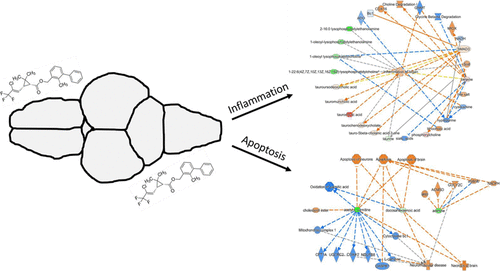当前位置:
X-MOL 学术
›
Environ. Sci. Technol.
›
论文详情
Our official English website, www.x-mol.net, welcomes your feedback! (Note: you will need to create a separate account there.)
Metabolomic Profiles in the Brains of Juvenile Steelhead (Oncorhynchus mykiss) Following Bifenthrin Treatment.
Environmental Science & Technology ( IF 11.4 ) Pub Date : 2020-09-09 , DOI: 10.1021/acs.est.0c04847 Jason T Magnuson 1 , Zachary Cryder 1 , Nicolette E Andrzejczyk 1 , Gary Harraka 1 , Douglas C Wolf 1 , Jay Gan 1 , Daniel Schlenk 1, 2
Environmental Science & Technology ( IF 11.4 ) Pub Date : 2020-09-09 , DOI: 10.1021/acs.est.0c04847 Jason T Magnuson 1 , Zachary Cryder 1 , Nicolette E Andrzejczyk 1 , Gary Harraka 1 , Douglas C Wolf 1 , Jay Gan 1 , Daniel Schlenk 1, 2
Affiliation

|
The pyrethroid insecticide, bifenthrin, is frequently measured at concentrations exceeding those that induce acute and chronic toxicity to several invertebrate and fish species residing in the Sacramento-San Joaquin Delta of California. Since the brain is considered to be a significant target for bifenthrin toxicity, juvenile steelhead trout (Oncorhynchus mykiss) were treated with concentrations of bifenthrin found prior to (60 ng/L) and following (120 ng/L) major stormwater runoff events with nontargeted metabolomics used to target transcriptomic alterations in steelhead brains following exposure. Predicted responses were involved in cellular apoptosis and necrosis in steelhead treated with 60 ng/L bifenthrin using the software Ingenuity Pathway Analysis. These responses were predominately driven by decreased levels of acetyl-l-carnitine (ALC), docosahexaenoic acid (DHA), and adenine. Steelhead treated with 120 ng/L bifenthrin had reductions of lysophosphatidylcholines (LPC), lysophosphatidylethanolamines (LPE), and increased levels of betaine, which were predicted to induce an inflammatory response. Several genes predicted to be involved in apoptotic (caspase3 and nrf2) and inflammatory (miox) pathways had altered expression following exposure to bifenthrin. There was a significantly increased expression of caspase3 and miox in fish treated with 120 ng/L bifenthrin with a significant reduction of nrf2 in fish treated with 60 ng/L bifenthrin. These data indicate that bifenthrin may have multiple targets within the brain that affect general neuron viability, function, and signaling potentially through alterations in signaling fatty acids.
中文翻译:

联苯菊酯治疗后幼年Steelhead(Oncorhynchus mykiss)脑中的代谢组学特征。
拟除虫菊酯杀虫剂联苯菊酯的浓度通常超过对加利福尼亚萨克拉曼多-圣华金三角洲的几种无脊椎动物和鱼类造成急性和慢性毒性的浓度。由于大脑被认为是联苯菊酯毒性的重要靶标,因此少年硬脑鳟(Oncorhynchus mykiss)在主要暴雨径流事件发生之前(60 ng / L)和之后(120 ng / L)发现浓度的联苯菊酯进行处理,并使用非靶向代谢组学来靶向暴露后钢头脑的转录组变化。使用Ingenuity Pathway Analysis软件,用60 ng / L联苯菊酯处理的硬皮病,预计的反应与细胞凋亡和坏死有关。这些反应主要是由乙酰-1-肉碱(ALC),二十二碳六烯酸(DHA)和腺嘌呤水平降低所驱动。用120 ng / L联苯菊酯处理的Steelhead的溶血磷脂酰胆碱(LPC),溶血磷脂酰乙醇胺(LPE)减少,甜菜碱水平升高,据预测可引起炎症反应。几个基因预计会参与凋亡(暴露于联苯菊酯后,半胱天冬酶3和nrf 2)和炎性(miox)途径的表达发生了改变。用120 ng / L联苯菊酯处理的鱼中caspase 3和miox的表达显着增加,而用60 ng / L联苯菊酯处理的鱼中的nrf 2显着降低。这些数据表明联苯菊酯在大脑中可能具有多个靶点,这些靶点可能会影响信号传导脂肪酸的变化,从而影响一般神经元的活力,功能和信号传导。
更新日期:2020-10-06
中文翻译:

联苯菊酯治疗后幼年Steelhead(Oncorhynchus mykiss)脑中的代谢组学特征。
拟除虫菊酯杀虫剂联苯菊酯的浓度通常超过对加利福尼亚萨克拉曼多-圣华金三角洲的几种无脊椎动物和鱼类造成急性和慢性毒性的浓度。由于大脑被认为是联苯菊酯毒性的重要靶标,因此少年硬脑鳟(Oncorhynchus mykiss)在主要暴雨径流事件发生之前(60 ng / L)和之后(120 ng / L)发现浓度的联苯菊酯进行处理,并使用非靶向代谢组学来靶向暴露后钢头脑的转录组变化。使用Ingenuity Pathway Analysis软件,用60 ng / L联苯菊酯处理的硬皮病,预计的反应与细胞凋亡和坏死有关。这些反应主要是由乙酰-1-肉碱(ALC),二十二碳六烯酸(DHA)和腺嘌呤水平降低所驱动。用120 ng / L联苯菊酯处理的Steelhead的溶血磷脂酰胆碱(LPC),溶血磷脂酰乙醇胺(LPE)减少,甜菜碱水平升高,据预测可引起炎症反应。几个基因预计会参与凋亡(暴露于联苯菊酯后,半胱天冬酶3和nrf 2)和炎性(miox)途径的表达发生了改变。用120 ng / L联苯菊酯处理的鱼中caspase 3和miox的表达显着增加,而用60 ng / L联苯菊酯处理的鱼中的nrf 2显着降低。这些数据表明联苯菊酯在大脑中可能具有多个靶点,这些靶点可能会影响信号传导脂肪酸的变化,从而影响一般神经元的活力,功能和信号传导。



























 京公网安备 11010802027423号
京公网安备 11010802027423号